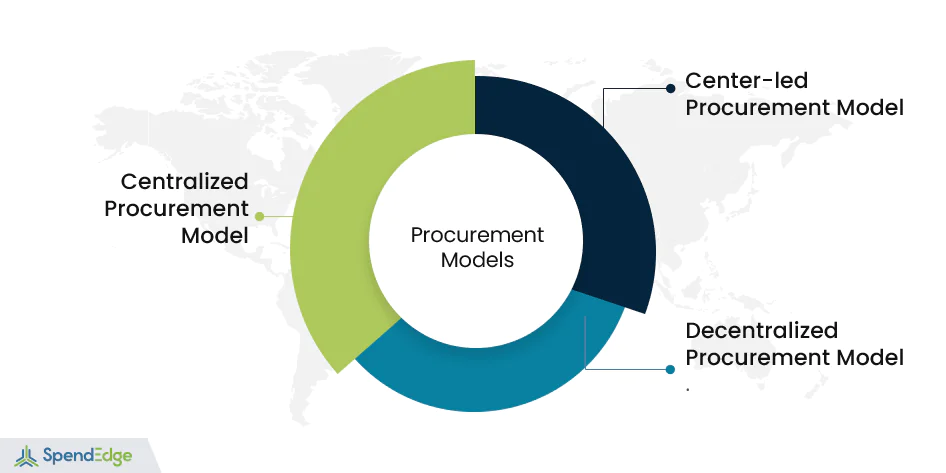Procurement is a vital function in any organization, impacting cost, quality, and operational efficiency. In today’s dynamic business environment, organizations have several types of procurement models to consider, with centralized, decentralized, and center-led being the most prominent.
This article explores the three key procurement models centralized, decentralized, and center-led detailing their characteristics, benefits, and challenges to help businesses make an informed decision.
Procurement Models: An Overview
In a centralized procurement process, procurement activities are managed by a single entity, typically at the company headquarters. This approach allows for spend management on a larger scale and enables the development of holistic category strategies. However, it may face challenges related to compliance and standardized processes across different regions or divisions.
Conversely, in a decentralized procurement model, procurement decisions are made at the regional or divisional level. This approach provides greater flexibility and responsiveness to local needs but may result in duplication of efforts and lack of standardization. The center-led procurement model strikes a balance between the two approaches by establishing a specialized team at the center to oversee procurement activities while allowing business units or functional/geographic units to manage day-to-day procurement operations.
This model is particularly advantageous for global companies seeking to achieve practicality and supplier diversity while maintaining centralized oversight. Key considerations in procurement include environmental sustainability, governance agenda, and fostering relationships with key suppliers. Additionally, factors such as seasonal discounting and market volatility influence procurement decisions and strategies.
Here’s how SpendEdge can help organizations, have a look at our services
Types of procurement models

Centralized Procurement Model
Centralized procurement involves consolidating the purchasing activities of an organization into a single department or unit. In this model, all procurement decisions and transactions are managed and executed from a central authority, typically the corporate headquarters.
Centralized procurement offers several advantages:
One of the primary advantages of centralization is the potential for cost savings through bulk purchasing. By aggregating the purchasing power, organizations can negotiate better deals, secure volume discounts, and reduce administrative costs associated with multiple procurement locations. Centralized procurement enables standardized processes, which can lead to better control and consistency in procurement activities. Standardized processes can help in maintaining quality standards and compliance with regulations. Centralized teams can develop expertise in specific categories or industries, enhancing their ability to negotiate favorable terms and conditions. They can also stay updated on market trends and changes, which can be beneficial for the organization. With a central point of contact, suppliers can build stronger and more strategic relationships with the organization. This can lead to better communication, reduced lead times, and better alignment with the organization’s goals.
Centralized procurement can facilitate better risk management by monitoring and mitigating potential supply chain disruptions. It allows for greater visibility and control over the entire procurement process.
Centralized procurement can facilitate better risk management by monitoring and mitigating potential supply chain disruptions. It allows for greater visibility and control over the entire procurement process.
Challenges in adopting a centralized procurement model
Centralized procurement process may struggle to adapt to local market conditions and cultural differences. This can result in suboptimal purchasing decisions in some regions. The model can be bureaucratic, with decision-making processes often taking longer due to the need for approvals and coordination across various departments or regions.
Centralization may limit the ability to respond quickly to changing market conditions or urgent needs in various parts of the organization. Employees in decentralized regions may resist the centralized model, feeling that it infringes on their autonomy and decision-making authority.
Decentralized Procurement Model
In contrast, a decentralized procurement model distributes procurement responsibilities across various departments or regions within an organization. Each local unit or division manages its procurement, making decisions independently.
Decentralized procurement offers its own set of advantages:
Decentralization allows for a deeper understanding of local markets and conditions. Local procurement teams can respond more effectively to regional nuances and opportunities. Decentralized models are often faster in decision-making and can adapt quickly to changing circumstances. This agility is valuable in industries with rapidly evolving market conditions. It empowers local employees to make procurement decisions, fostering a sense of ownership and accountability. This can lead to increased job satisfaction and motivation. The procurement model tend to have less bureaucratic overhead, resulting in quicker response times and fewer layers of approval.
Cons of decentralized procurement:
Distributing procurement responsibilities across multiple units can lead to inefficiencies, as each unit may miss out on potential savings through bulk purchasing. Different units may have varying standards and preferences, which can lead to inconsistencies in product or service quality. Smaller procurement units may struggle to negotiate favorable terms with suppliers, as they lack the purchasing volume of a centralized model. Decentralized models can be more challenging to manage from a compliance and risk perspective, as they may not have the same level of control and visibility over all procurement activities.
Center-led Procurement Model
The center-led procurement model is a strategic approach to procurement management that strikes a balance between centralization and decentralization. It involves establishing a centralized procurement center, often referred to as a procurement hub or center of excellence, that coordinates and oversees procurement activities throughout the organization. However, it also allows individual business units or subsidiaries a degree of autonomy to meet their specific needs.
Key Principles
Centralized Oversight: In a center-led procurement model, the procurement center plays a pivotal role in setting procurement policies, strategies, and standards. It ensures adherence to best practices, regulatory compliance, and economies of scale, thus enabling better control and visibility over the procurement process.
Business Unit Autonomy: Business units are encouraged to participate in procurement decisions that align with their unique requirements. They have the flexibility to select suppliers and negotiate contracts, but within the framework and guidelines established by the procurement center.
Advantages of a center-led model
By leveraging the procurement center’s expertise and negotiating power, organizations can realize substantial cost savings through bulk purchasing, supplier consolidation, and optimized contracts. Standardized procurement processes and practices ensure consistency and compliance across the organization. This minimizes the risk of errors and non-compliance with regulations. A centralized approach allows for better risk management and monitoring of supplier performance. The procurement center can respond proactively to potential disruptions. With all procurement data consolidated, organizations can harness advanced analytics to gain insights into their spending patterns, supplier performance, and areas for improvement. The procurement center can cultivate and maintain strong supplier relationships, fostering collaboration and innovation while maintaining a balance of power.
Challenges with a center-led procurement model
Implementing a center-led model can face resistance from business units accustomed to autonomy in their procurement activities. Clear communication and change management are essential. Striking the right balance between centralization and autonomy can be challenging. Over-centralization may stifle innovation and hinder responsiveness to unique business unit needs. Establishing and maintaining a procurement center demands significant resources, both financial and human. Smaller organizations may struggle to meet these requirements. Effective use of technology is vital in a center-led model. Integration with existing systems and data sharing between business units and the procurement center can be complex.
Selecting the Right Model
Choosing between different procurement model depends on factors like, an organization’s size, industry, strategic objectives, and the balance between standardization and localization. Here are some key considerations for selecting the right model:
Size and Complexity: Larger organizations stands a chance to benefit from centralization due to their purchasing power and the need for uniform standards. Smaller organizations or those with diverse product lines might find decentralization more suitable.
Industry: Industries with rapidly changing market conditions favor decentralization for its agility, while highly regulated industries might lean towards centralization to ensure compliance.
Geographic Reach: If an organization operates in multiple regions or countries, it can opt for a hybrid model that combines elements of both centralization and decentralization.
Strategic Objectives: The organization’s strategic goals, such as cost reduction, innovation, or market expansion, plays the deciding role in the choice of procurement model.
Technology and Systems: The availability of technology and systems to support procurement processes can influence the feasibility of both models.
Cultural Factors: Employee culture and willingness to adapt to a specific model can also play a crucial role in its success.
For more detailed information
Conclusion
In conclusion, understanding and selecting the right procurement model is essential for enhancing procurement efficiency and aligning with organizational goals. Centralized models offer control and standardization, while decentralized models bring agility and local responsiveness. For many organizations, a center-led model offers the best of both worlds.
Exploring various types of procurement models helps organizations tailor their strategies, ensuring they meet both global standards and local needs. Ultimately, the goal is to build a procurement function that drives value, manages risk, and supports long-term growth.





